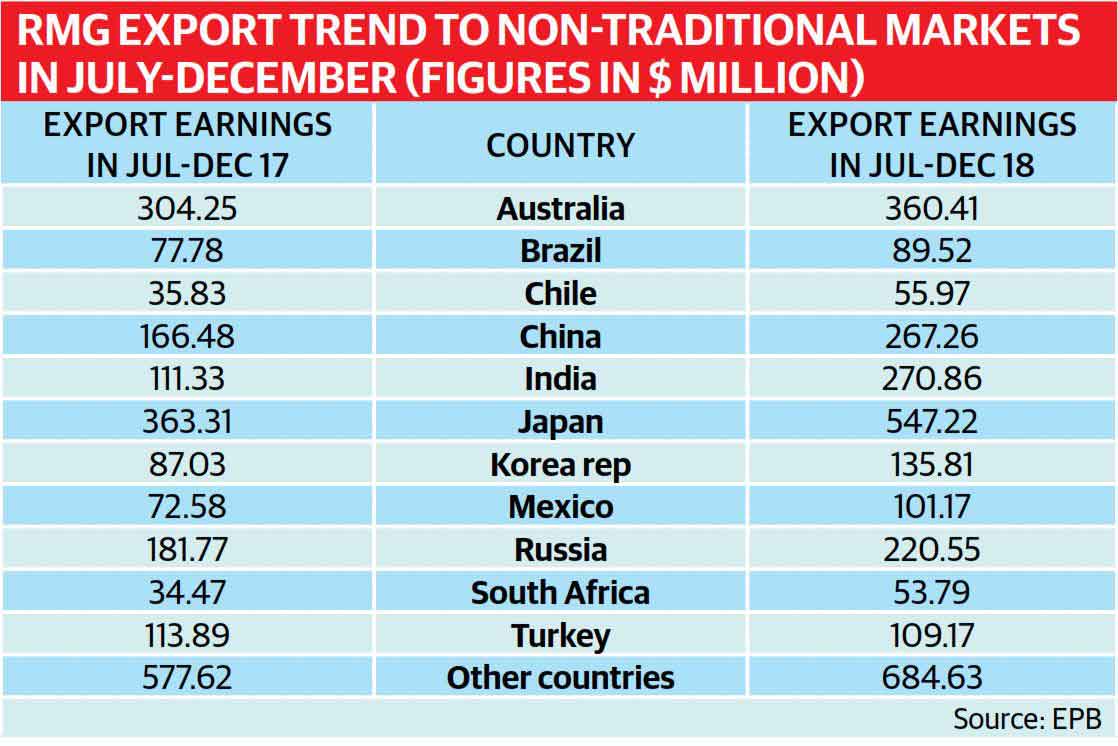Australia, Brazil; Chile; China; India; Japan; Korea; Mexico; Russia; South Africa; and Turkey are the major non-traditional countries that showed huge potential for Bangladeshi apparel products
Bangladesh’s apparel shipments to new export destinations have posted robust growth of 36.21% in the first half of the current fiscal year, riding mainly on enhanced cash incentive and initiatives of exporters to diversify their markets. Australia, Brazil; Chile; China; India; Japan; Korea; Mexico; Russia; South Africa; and Turkey are the major non-traditional countries that showed huge potential for Bangladeshi apparel products, besides the traditional markets of the US and the European Union, shows data of the Export Promotion Bureau (EPB)In the July-December period of the current FY2018-19, earnings from apparel products from non-traditional countries reached $2.90 billion, up from $2.12 billion in the previous fiscal year (FY2017-18). Of the total amount, knitwear products earned $1.44 billion, which was 29.52% higher than $1.11 billion in the corresponding period of FY2017-18. Woven goods fetched $1.45 billion, up by 43.58% from $1.01 billion in the first half of the previous fiscal year. Total apparel exports of the country saw a 15.65% growth to $17.08 billion in the same period of the current fiscal year. Speaking to the Dhaka Tribune, trade experts and industry stakeholders cited policy support measures from the government and increased cash incentives against export to non-traditional markets as the main drivers for the sharp rise in export earnings from new export destinations. Managing Director of MB Knit Fashion Mohammad Hatem said: “Apparel exporters now enjoy 4% cash incentives against export to non-traditional markets, which encourage them to explore new destinations for their products. “Additionally, these cash incentives allow apparel makers to practice competitive pricing in the global market,” added Hatem, also former vice president of the Bangladesh Knitwear Manufacturers and Exporters Association (BKMEA). Bangladesh’s government raised cash incentives against export to non-traditional markets to 4% this fiscal year from 3% in FY2017-18, with an aim to boost exports to new markets.

Former vice president of the Bangladesh Garment Manufacturers and Exporters Association (BGMEA) ShahidullahAzim said manufacturers are now participating in several expos to establish contacts with buyers from non-traditional markets, adding that this is also having an impact in terms of export earnings growth from new export destinations. “In the months to come, export earnings from non-traditional export markets will rise further as China and India are giving more importance in importing clothing products for local consumption and global retailers are opening new outlets in India,” Azimadded.Trade experts opine that improvement in safety standards in Bangladesh’s ready-made garment (RMG) factories, and buyers’ relocating their sourcing destinations also helped to increase export earnings.Speaking about the US-China trade-war role in Bangladesh’s export earnings growth, former caretaker government adviser AB MirzaAzizul Islam, said: “Due to tariff tensions between China and the US, buyers are relocating their sourcing destinations—and Bangladesh is a top alternative for buyers.”He opined that this is why Bangladesh’s exports to non-traditional markets have seen a sharp rise, furthering that a “significant rise” in export to new markets is a “good sign” for Bangladesh and indicates a reduction of dependency on traditional markets.”In retaining the growth momentum, Bangladesh has to identify buyers’ priorities and design a strategy to develop its product basket to cater to buyers requirements,” Islam added.Exporters Association of Bangladesh (EAB) president Abdus Salam Murshedy said that exports to new destinations is a reflection of buyers’ confidence, which has been boosted by improved safety standards in the industry. “Following the completion of the Accord on Fire and Building Safety in Bangladesh and the Alliance for Bangladesh Workers Safety agreements, Bangladesh is now the safest workplace in the world,” said Salam. He also urged the government to work for more bilateral negotiations and trade agreements to avail duty-free access to markets with high tariffs. Which countries are non-traditional markets for Bangladesh? Non-traditional markets for Bangladesh’s for apparel exports include: Australia; Brazil; Chile; China; India; Japan; Korea; Mexico; Russia; South Africa; and Turkey—while traditional markets are the United States and countries in Europe.For the first half of FY2018-19, apparel exports to Japan stood at $547 million, the highest in non-traditional export destination category, up by 50.62% from $363.31 million in the same period of FY2017-18. Apparel exports to Australia were the second-highest with a growth of 18.46% to $360 million in FY2018-19 from $304.24 million in FY2017-18.India was the third largest traditional export market for apparel products from Bangladesh during the period, fetching $270 million, up by 143.30% compared to $111.33 million in the same period of FY2017-18.
















